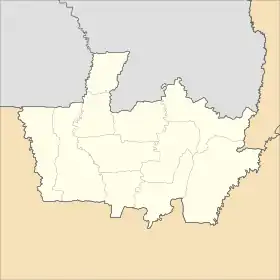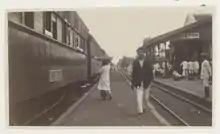B21 Depok Station Stasiun Depok | |||||||||||||||
|---|---|---|---|---|---|---|---|---|---|---|---|---|---|---|---|
| Commuter line station | |||||||||||||||
 Front view of Depok station, 2020. | |||||||||||||||
| General information | |||||||||||||||
| Location | Jl. Stasiun Depok Lama, Pancoran Mas, Pancoran Mas, Depok West Java Indonesia | ||||||||||||||
| Coordinates | 6°24′16″S 106°49′02″E / 6.404422°S 106.817086°E | ||||||||||||||
| Elevation | +93 m (305 ft) | ||||||||||||||
| Owned by | Kereta Api Indonesia | ||||||||||||||
| Operated by | KAI Commuter | ||||||||||||||
| Line(s) | |||||||||||||||
| Platforms | 2 island platforms | ||||||||||||||
| Tracks | 4 | ||||||||||||||
| Construction | |||||||||||||||
| Structure type | Ground | ||||||||||||||
| Parking | |||||||||||||||
| Bicycle facilities | |||||||||||||||
| Accessible | |||||||||||||||
| Other information | |||||||||||||||
| Station code | DP • 0706[1] | ||||||||||||||
| Classification | Large class type C[1] | ||||||||||||||
| History | |||||||||||||||
| Opened | 31 January 1873 (as Depok NIS station),
1920~ (Taken-over by SS) 1939 (Cooperated and Integrated with TTSM) | ||||||||||||||
| Rebuilt | 1988[2] | ||||||||||||||
| Electrified | 6 April 1925[3] | ||||||||||||||
| Original company | Nederlandsch-Indische Spoorweg Maatschappij | ||||||||||||||
| Passengers | |||||||||||||||
| 2018 | 9.1 million[4] | ||||||||||||||
| Services | |||||||||||||||
| |||||||||||||||
| Location | |||||||||||||||
 Depok Station Location in Depok | |||||||||||||||
Depok Station (DP)[1] is a railway station located in Pancoran Mas, Pancoran Mas, Depok, West Java. This station is commonly known as Depok Lama (Old Depok), to distinguish with Depok Baru (lit. 'New Depok') Station. The station is one of the oldest station in Jakarta metropolitan area. At present it serves as a station of Jakarta Commuter Rail. Depok EMU depot is located to the southwest of the station.
Since 25 March 2021, this station along with Bekasi, Tanah Abang, Kranji, Jakarta Kota, Depok Baru, Bojonggede, Citayam, Parungpanjang and Angke stations officially ceased the sale of Guaranteed Daily Tickets (Indonesian: Tiket Harian Berjaminan or THB) for KRL Commuterline services.[5]
History


In the 17th to 18th centuries, Depok was a kawedanan area as well as a plantation founded by the landlord Cornelis Chastelein.[6] Until the 19th century the city that Chastelein built continued to grow. Given the increasing need for transporting plantations and passengers, in the late 1860s the Batavia–Buitenzorg railway line was built by the Nederlandsch-Indische Spoorweg Maatschappij, the first heavy rail company in the Dutch East Indies.
The station was opened by the NIS at the same time as the opening of the last segment, Meester Cornelis N.I.S.–Buitenzorg on 31 January 1873.[7] Unlike the Samarang–Vorstenlanden railway, which uses a gauge width of 1,435 mm, the NIS uses a 1,067 mm gauge for this route.[8] On 1 November 1913, the Staatsspoorwegen officially purchased the NIS assets on the line and eventually developed this station.[9]
In connection with the development of SS services, electric trains and electric locomotives have started running on the Tandjongpriok (Tanjung Priuk)–Batavia–Buitenzorg and Tandjongpriok–Meester Cornelis (Jatinegara) lines. To realize this, the SS built overhead line poles along these lines, and on 6 April 1925, the electric multiple unit started operating in conjunction with the 50th anniversary of Staatsspoorwegen's contributions in Java.[10]
At the end of the '80s, the Depok Station was rebuilt, all the old lines, the old catenary pole, demolished because the line from Manggarai–Depok was built double tracks. Since then, the old building has ceased to exist. While the double tracks from Depok Station to Bogor was only completed in the late '90s, after the 1993 Ratu Jaya train accident between Depok Station with Citayam Station made the existence of a double track important.[11]
Building and layout
To the south from Depok Station, there is a KRL depot, which is the largest in Southeast Asia. Now this station has four lines to speed up KRL Commuterline trips from Bogor and for the final stop for trains bound for Depok Station. Depok Station has its own uniqueness. If in general stations that have 4 lines, such as Gambir, upper Manggarai, Tambun, Pasar Minggu, and Cakung Stations, lines 2 and 3 are straight tracks, then Depok Station lines 1 and 4 are straight tracks.
| G | Main building | |||
| P
Platform floor |
Line 1 | ← (Depok Baru) | ||
| Island platform, the doors are opened on the left side of the train arrival on line 1, or on the right side of the train arrival on line 2 | ||||
| Line 2 | ← (Depok Baru) | (Citayam) → | ||
| Line 3 | ← (Depok Baru) | (Citayam) → | ||
| Island platform, the doors are opened on the right side of the train arrival on line 3, or on the left side of the train arrival on line 4 | ||||
| Line 4 | (Citayam) → | |||
| G | West gate and ticket lockets | |||
Services
The following is a list of train services at the Depok Station.
Passenger services
- KAI Commuter
 Bogor Line, to Jakarta Kota and Bogor
Bogor Line, to Jakarta Kota and Bogor Bogor Line (Nambo branch), to Jakarta Kota and Nambo
Bogor Line (Nambo branch), to Jakarta Kota and Nambo
Supporting transportation
| Public transport type | Line | Destination |
|---|---|---|
| Angkot[12] | D05 | Depok Bus Terminal–Bojong Gede Bus Terminal |
| D05A | Citayam Bus Terminal–Grand Depok City Boulevard–Jatijajar | |
| D10A | Depok Bus Terminal–Grand Depok City Boulevard–Jatijajar |
Incidents
- On 25 July 2013, a KRL Commuterline train was on fire on 09:14 WIB. It was suspected that the fire was caused by AC compressor malfuction.[13]
- On 5 December 2018, a KRL Commuterline train emits thick white smoke. There were no casualties, but caused panic among passengers. As a result, the passengers had to be diverted and the fleet immediately brought to the Depok KRL Depot for inspection.[14][15]
References
- 1 2 3 Buku Informasi Direktorat Jenderal Perkeretaapian 2014 (PDF) (in Indonesian). Archived from the original (PDF) on 1 January 2020.
- ↑ Sejarah Penataan Kereta Commuter Line Seri I - Pusat Data dan Analisa TEMPO - Google Books (in Indonesian). 7 January 2019. ISBN 9786232076143.
- ↑ "Awal Mula Jalur Layang Kereta di Indonesia - Historia" (in Indonesian). Hendaru Tri Hanggoro.
- ↑ "Commuter Line Passes Milestone of 1m Daily Passengers". Jakarta Globe. 20 November 2019. Retrieved 26 May 2020.
- ↑ Anwar, Muhammad Choirul (18 March 2021). "Mulai 25 Maret, 10 Stasiun KRL Ini Tak Layani Tiket Harian Berjaminan". KOMPAS.com (in Indonesian). Retrieved 12 March 2023.
- ↑ "Cornelis Chastelein; Tuan Tanah Baik Hati Pembangun Depok". Republika Online (in Indonesian). 15 July 2019. Retrieved 12 March 2023.
- ↑ Statistiek van het vervoer op de spoorwegen en tramwegen met machinale beweegkracht in Nederlandsch-Indië. Batavia: Landsdrukkerij. 1896.
- ↑ Poolman, W. Verslag van den raad van beheer der Nederlandsch-Indische Spoorweg-Maatschappij...28sten Junij 1870. Amsterdam: C.A. Spin & Zoon.
- ↑ aegie (ed.), Van Kleine Boom Naar Buitenzorg Via Meester Cornelis (in Indonesian), retrieved 26 April 2010
- ↑ Reitsma, S.A (1925). Gedenkboek der staatspoor- en tramwegen in Nederlandsch-Indië, 1875-1925. Weltevreden: Topografische Inrichting.
- ↑ Sejarah Penataan Kereta Commuter Line. Jakarta: Tempo Publishing. 2019. ISBN 9786232076143.
- ↑ "Rute Angkot di Depok". e-transportasi.com. Retrieved 12 March 2023.
- ↑ Virdhani, Marieska Harya (25 July 2013). "KRL Commuter Line Terbakar di Stasiun Depok". Okezone.com (in Indonesian). Retrieved 12 March 2023.
- ↑ Pradipto, Deodatus (5 December 2018). Pradipto, Deodatus (ed.). "KRL Commuter Line Tujuan Bogor Keluarkan Asap di Stasiun Depok, Penumpang Dievakuasi". Tribunnews.com (in Indonesian). Retrieved 12 March 2023.
- ↑ Mardiyansyah, Khafid (5 December 2018). "KRL yang Mengeluarkan Asap Sudah Dievakuasi ke Dipo Stasiun Depok". Okezone.com (in Indonesian). Retrieved 12 March 2023.
External links
 Media related to Depok Station at Wikimedia Commons
Media related to Depok Station at Wikimedia Commons
| Preceding station | Kereta Api Indonesia | Following station | ||
|---|---|---|---|---|
| Depok Baru towards Manggarai |
Manggarai–Padalarang | Citayam towards Padalarang |